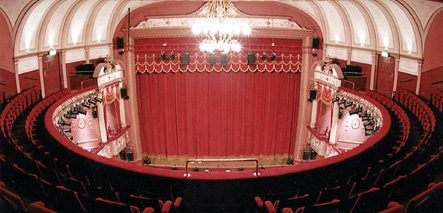When the ceiling at the Apollo Theatre in London collapsed during a performance of The Curious Incident of the Dog in the Night-Time last December, injuring 80 people, theatre owners across the country quickly organised inspections. But what were they looking for? Steve Menary reports.
Only three months after the collapse at the Apollo Theatre did Westminster City Council identify the cause as deterioration of wadding ties that had supported the theatre’s ceiling since 1901. Interim guidance was issued advising immediate inspection from above of ties on all suspended ornate ceilings by a ‘competent historic plaster specialist and a structural engineer’.
But a full report into the collapse has not been published, the council describes the probe as “ongoing”, and specialists working in the sector say there is an urgent need to put a new system in place.
 Ronnie Clifford, managing director of specialist Ornate Interiors, said: “It’s still up in the air how it’s going forward. There needs to be a framework put in place on how to survey these structures. The problem is that this will cost if we are looking at plaster and structures, then that will need a structural engineer. It has a knock-on effect with the insurance companies.”
Ronnie Clifford, managing director of specialist Ornate Interiors, said: “It’s still up in the air how it’s going forward. There needs to be a framework put in place on how to survey these structures. The problem is that this will cost if we are looking at plaster and structures, then that will need a structural engineer. It has a knock-on effect with the insurance companies.”
The fibrous plaster sector is left in limbo until the report comes out. No-one wants to discuss the Apollo specifically, but Saint-Gobain has not been asked for any specific information on its Formula product since the incident and specialist contractors agree that working methods have not changed.
Hayles & Howe has worked on theatres for over 30 years. Managing director David Harrison said: “Nothing has changed. We’re still carrying out very thorough inspections. Now we’re doing more, but our methods haven’t changed.”
With the way forward unclear, the Association of British Theatre Technicians (ABTT) is looking to take the lead. Hayles & Howe and another experienced fibrous specialist, Locker & Riley, have been working with the ABTT, which will produce its own guidance ahead of a wave of expected new theatre work in the wake of the Apollo collapse.
Mark White, chairman of the ABTT communications and publications committee, said: “In the aftermath of the incident at the Apollo Theatre, there have been a huge number of inspections of theatre ceilings in particular, as you would expect,
around the country and a lot of remedial work has been brought forward as theatre owners take this extremely seriously.”
The ABTT, which will not comment on the Apollo Theatre collapse, is in the process of drawing up guidance and expects this to be published in its own publication, Technical Standards for Places of Entertainment, due out this month.
The guidance, which will also be circulated more widely to both theatre owners and contractors, suggests a base-line survey of the existing conditions of the structural elements and the plaster elements of suspended ceilings in theatres to be carried out by a chartered structural engineer alongside a ‘competent’ plastering contractor.
The aims of this survey will be to look for signs of water damage, structural shifts or deterioration in stability, impact damage and the attachment of all suspended parts to the main structure of the building.
Mr White added: “Plaster ceilings in particular should be able to be inspected from both above and below and any obstructions that would prevent this from happening should be removed. This also means that the top of ceilings, the surface not seen from the room below, needs to be cleaned and kept free of a build-up of dust and other detritus.”
The ABTT is advising no changes to the ceiling and voids without approval of a structural engineer, implementation of a regular inspection and cleaning regime, and the appointment of what it describes as a ‘ceilings champion’ from amongst the theatre staff to monitor the ceiling. Their work would involve taking regular digital photographs.
While all this will make sense to most plastering contractors working on historic buildings, for specialist contractors working in the sector there is also a need to ensure the right craftsmen are recruited to work on historic buildings, such as theatres.
Hayles & Howe and Locker & Riley are also working with AIS FPDC, which in the New Year will launch a new heritage group to lobby for better training of fibrous craftsmen. Mr Harrison added: “It’s about doing it properly. There are a limited number of people who are doing it properly and some that are not.”
The AIS FPDC wants only those with the right skills, such as an NVQ, to be able to work on historic buildings but Mr Clifford said that changes should go further. “We’ve got an NVQ heritage card to say we can work on these buildings, but is there going to be a list of people who are qualified to check these works?” he asked. “No-one knows where it’s going to end. What it needs is a proper licensed system going forward so that work is carried out the same way every time, but this comes at a cost that will weigh heavily.”


